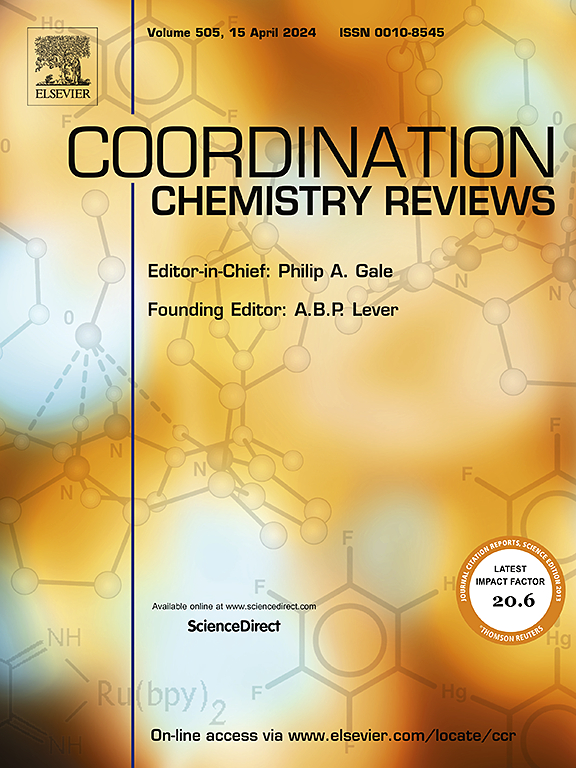催化纳米酶:打开关节软骨退变治疗的新视野
IF 20.3
1区 化学
Q1 CHEMISTRY, INORGANIC & NUCLEAR
引用次数: 0
摘要
关节软骨疾病是世界范围内最普遍和最衰弱的健康状况之一,严重损害患者的生活质量,给医疗保健系统带来重大负担。现有的治疗策略主要侧重于缓解症状和减缓疾病进展;然而,它们的功效往往是有限的,并可能与严重的不良反应有关。由于其独特的催化性能和生物相容性,纳米酶已成为关节软骨疾病的治疗药物。它们可以通过抗氧化和抗炎途径减轻关节炎症,同时促进软骨再生和修复,从而提供创新的治疗机会。近年来,各种纳米酶被设计和应用于关节软骨疾病的治疗。本文综述了纳米酶治疗关节软骨疾病的进展。它从检查这些疾病的普遍影响开始,解决当前治疗方法的限制,并强调纳米酶研究的进展。接下来,讨论了通过密度泛函理论、机器学习、仿生设计和化学工程等技术合理设计和合成纳米酶。本文还简要阐述了纳米酶发挥治疗作用的催化机制。随后,关注关节软骨的炎症微环境,这是这些疾病发生和发展的核心。综述总结了纳米酶在关节软骨疾病治疗中应用的最新发现,并描述了涉及纳米酶为基础的干预的临床挑战。最后,它确定了当前的挑战,并探讨了将纳米酶整合到关节软骨疾病的治疗策略中的未来前景。本文章由计算机程序翻译,如有差异,请以英文原文为准。

Catalytic Nanozyme: Unlocking new horizons in articular cartilage degeneration treatment
Articular cartilage diseases rank among the most prevalent and debilitating health conditions worldwide, substantially impairing patients' quality of life and placing significant burdens on healthcare systems. Existing therapeutic strategies primarily focus on alleviating symptoms and decelerating disease progression; however, their efficacy is often constrained and may be associated with substantial adverse effects. Owing to their unique catalytic properties and biocompatibility, nanozymes have emerged as promising therapeutic agents for articular cartilage diseases. They can mitigate joint inflammation via antioxidant and anti-inflammatory pathways while promoting cartilage regeneration and repair, thereby providing innovative treatment opportunities. Recent years have witnessed the design and application of diverse nanozymes for articular cartilage disease management. This review provides a comprehensive overview of the progress in nanozyme-based therapies for articular cartilage diseases. It begins by examining the pervasive impact of these diseases, addresses the constraints of current therapeutic approaches, and highlights advances in nanozyme research. Next, it discusses the rational design and synthesis of nanozymes through techniques such as density functional theory, machine learning, biomimetic design, and chemical engineering. The catalytic mechanisms through which nanozymes exert therapeutic effects are also briefly elucidated. Subsequently, attention is directed to the inflammatory microenvironment in articular cartilage, which is central to both the onset and progression of these diseases. The review then summarizes the latest findings on nanozyme applications in articular cartilage disease treatment and describes the clinical challenges involving nanozyme-based interventions. Finally, it identifies current challenges and explores future prospects for integrating nanozymes into therapeutic strategies against articular cartilage diseases.
求助全文
通过发布文献求助,成功后即可免费获取论文全文。
去求助
来源期刊

Coordination Chemistry Reviews
化学-无机化学与核化学
CiteScore
34.30
自引率
5.30%
发文量
457
审稿时长
54 days
期刊介绍:
Coordination Chemistry Reviews offers rapid publication of review articles on current and significant topics in coordination chemistry, encompassing organometallic, supramolecular, theoretical, and bioinorganic chemistry. It also covers catalysis, materials chemistry, and metal-organic frameworks from a coordination chemistry perspective. Reviews summarize recent developments or discuss specific techniques, welcoming contributions from both established and emerging researchers.
The journal releases special issues on timely subjects, including those featuring contributions from specific regions or conferences. Occasional full-length book articles are also featured. Additionally, special volumes cover annual reviews of main group chemistry, transition metal group chemistry, and organometallic chemistry. These comprehensive reviews are vital resources for those engaged in coordination chemistry, further establishing Coordination Chemistry Reviews as a hub for insightful surveys in inorganic and physical inorganic chemistry.
 求助内容:
求助内容: 应助结果提醒方式:
应助结果提醒方式:


